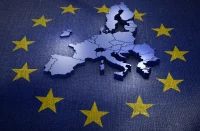Standard and Poor’s is warning that a credit rating downgrade might loom on the horizon for the EU as a whole, which is predictable news considering that 15 Eurozone countries have already ended up on the agency’s review list. The current round of hammering Europe is taking from the US rating agencies leaves little doubt that Euro is about to be confronted with a serious crash test.
Moody’s similarly announced that 87 banks from 15 European countries are candidates for rating cuts, the plausible explanation behind the step being that evidently they can no longer count on support from their financially embarrassed governments. From the classic free-market perspective, one is tempted to ask why governments should ever worry about the problems of private and independent institutions whose liabilities, like their revenues, are supposed to be exclusively their own business? The circumstance that does lend a political dimension to the situation is that when downgrades start to hang over heavyweights like NP Paribas, Societe Generale, Uni Credit, Santander, Credit Suisse and UBS, investors feel prompted to search for safer niches, which at the moment may only be found in the US. The outcome would certainly benefit the US economy which, in the process of climbing out of the crisis, desperately needs investments.
US rating agencies are not wasting any time. At the moment the majority of rating downgrade nominees are Spanish, Italian, Austrian, and French banks, but an avalanche of new cases involving individual banks is sure to follow across Europe now that S&P calls into question the standing of the entire EU.
The linkage between the rating agencies’ assessments and the US Administration’s policies being an open secret, Berlin, for example, seems shocked to realize that the US, Germany’s number one trade partner and traditional big brother, is obviously trying to bury Euro. German chancellor A. Merkel says the S&P negative projections are no reason to panic: “What a rating agency does is the responsibility of the rating agency”. She opined that the Eurozone is on track for getting out of crisis but added: “I have always said this is a long process and an arduous one and it will continue, but we charted the course yesterday with the French president and we will continue to steer the course”. This, however, is exactly what the US rating agencies attempt to prevent from happening, since Europe’s investment problems help lure investors to the US.
In the market economy, rating agencies are companies whose business is to assess the reliability of credit institutions and bonds, the quality of corporate governance and assets management, etc. Rating agencies offer a specific type of product – the credit ratings which, by reflecting financial risks, affect interest rates and the marketability of bonds. Simply speaking, higher ratings should correlate with lower financial risks. Rating downgrades tend to scare away financial players whose withdrawal can force banks or even whole countries to bow to investors’ demands. As a result, the forecasts churned out by rating agencies, which in fact bear no responsibility for whatever they say, can have a major political impact and emerge as a powerful political weapon. These days, the weapon is used against Euro and the EU.
Three years ago rating agencies showed appalling incompetence when they stamped top-notch ratings on pre-default US bond issuers and securities. The story has receded from the media discourse by now, and new rating agencies’ releases are in the spotlight while no efforts are made to probe into the causes behind their renewed acceptance.
Moody’s which monitors over Spanish, Italian, Austrian, and French banks threatens to reconsider their ratings as its analysts are somehow convinced that the European governments will not intervene under emergency conditions. What we do see is how the EU is struggling to make financial infusions – mainly at the expense of German taxpayers – into the budgets of Greece and Portugal, and plans to prop up Italy next year. Upon scrutiny, there are no serious grounds for the folks at Moody’s to believe that the assistance will dwindle in no time.
There are two key reasons why the US machinery of influencing other countries’ financial markets, including those of the US allies, is currently being overused.First, the European volatilities are pushing financial resources overseas as investors still trust the US economy more than any other, even though China is poised to outrun it within a decade. Secondly, it is clear that Washington has long been concerned over Europe’s growing centrality to the global finances, the strengthening of Euro which promises to become a viable alternative to the US dollar, and Europe’s plans to tap deep into the Asian energy reserves. For Washington, seizing the opportunity to hurt economic rivals must be an imperative.
The US has already drawn some benefits from the game played by the rating agencies: the S&P announcement immediately sent the oil prices sliding. In its wake, the Light Sweet Crude (WTI) and the Brent futures for January, 2012 traded electronically at $100.52 per barrel (an $0.47 decrease) and $109.27 per barrel (a $0.26 decrease), which added up to significant savings for the importers considering the overall trade volumes.
The rating agencies which are a predominantly US business spare no efforts to undermine the credibility of the European markets.The agencies are fairly hermetic, but, for example, the writings of Frederick William Engdahl, an experienced economist and a US dissenter resident in Germany, shed some light on their internal mechanics. As Engdahl stresses, “The top three rating agencies under US law enjoy an almost unique status. They are recognized by the Government’s Securities and Exchange Commission (SEC) as Nationally Recognized Statistical Rating Organizations (NRSROs)…Essentially, the top three hold a quasi monopoly on the credit rating business, and that, worldwide”. Furthermore, according to Engdahl, “The raters under US law were not liable for their ratings despite the fact that investors worldwide depend often exclusively on the AAA or other rating by Moody’s or S&P as validation of creditworthiness…The only US law regulating rating agencies, the Credit Agency Reform Act of 2006 is a toothless law, passed in the wake of the Enron collapse. Four days before the collapse of Enron, the rating agencies gave Enron an “investment grade” rating, and a shocked public called for some scrutiny of the raters. The effect of the Credit Agency Reform Act of 2006 was null on the de facto rating monopoly of S&P, Moody’s and Fitch”. Engdahl remarks that “Rule 10b-5 of the Securities and Exchange Act of 1934 is probably the most important basis for suing on the grounds of capital market fraud.” That rule stated “It shall be unlawful for any person…to make any untrue statement of a material fact… That sounded like something concrete. But then the Supreme Court affirmed in a 2005 ruling, Dura Pharmaceuticals, ratings are not “statements of a material fact” as required under Rule 10b-5. The ratings given by Moody’s or S&P or Fitch are rather, “merely an opinion.” They are thereby protected as “privileged free speech,” under the US Constitution’s First Amendment”. The approach is quintessentially American. In a free country, as Engdahl notes, S&P, Moody’s, or Fitch can express whatever views concerning Enron, Parmalat, or substandard securities.
On top of the above, anyone is also free to invent one’s own ways to make money in the free country. The assessments produced by credit rating agencies can cause economic damage, but the victims, especially in Europe, have no way of proving that fraud has taken place, regardless of whether investors relied excessively on raters’ estimates or manipulations with the estimates made security prices plummet. The key US principle – What is good for big money, is good for the nation – actually implies that the money must be US dollars…
Source: Strategic Culture Foundation














Comments